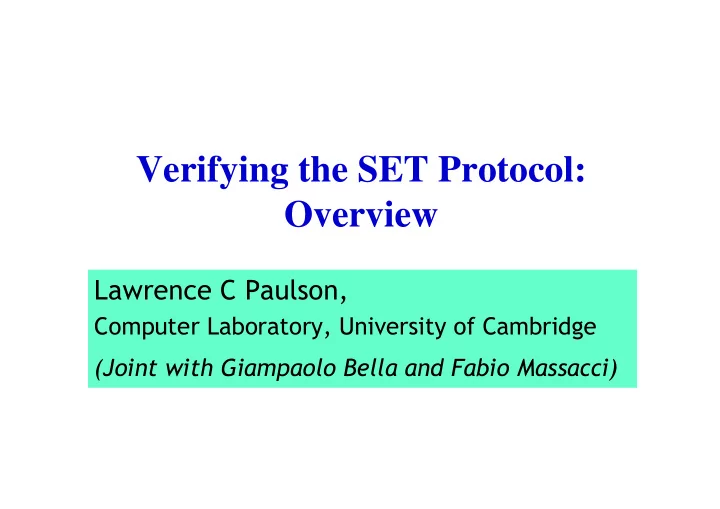

Verifying the SET Protocol: Overview Lawrence C Paulson, Computer Laboratory, University of Cambridge (Joint with Giampaolo Bella and Fabio Massacci)
Plan of Talk • The SET Protocol • Defining the Formal Models • Verifying the Registration Phase • Verifying the Purchase Phase 2 Lawrence C Paulson
Internet Shopping with SSL Credit card details SSL merchant cardholder “Curses! Can’t get that number!” 3 Lawrence C Paulson
Why Trust the Merchant? Credit card details?? “Now I can buy that software!” SSL cardholder 4 Lawrence C Paulson
Why Trust the Customer? Fake card details “Send MS Office, charge to my merchant SSL card…” 5 Lawrence C Paulson
Basic Ideas of SET • Cardholders and Merchants must register • They receive electronic credentials – Proof of identity – Evidence of trustworthiness • Payment goes via the parties’ banks – Merchants don’t need card details – Bank does not see what you buy 6 Lawrence C Paulson
Plan of Talk • The SET Protocol • Defining the Formal Models • Verifying the Registration Phase • Verifying the Purchase Phase 7 Lawrence C Paulson
Inductive Protocol Verification • Define system’s operational semantics • Include honest parties and an attacker • Model each protocol step in an inductive definition • Prove security properties by induction • Mechanize using Isabelle/HOL 8 Lawrence C Paulson
An Overview of Isabelle • Generic: higher-order logic, set theory, … • Good user interface (Proof General) • Automatic document generation • Powerful simplifier and classical prover • Strong support for inductive definitions 9 Lawrence C Paulson
The SET Documentation • Business Description – General overview – 72 pages • Programmer’s Guide – Message formats & English description of actions – 619 pages • Formal Protocol Definition – Message formats & the equivalent ASN.1 definitions – 254 pages 10 Lawrence C Paulson
SET Digital Envelopes • Consisting of two parts: – Symmetric key K, encrypted with a public key – Main ciphertext, encrypted with K • Hashing to link the two parts • Minimal use of public-key encryption • Great complications for formal reasoning – Numerous session keys in use – Dependency chains: keys encrypt keys 11 Lawrence C Paulson
Obstacles to Formalization • Huge size of documentation & protocol • Lack of explicit objectives • “Out of band” steps • Many types of participants: – Cardholders – Merchants – Certificate Authorities – Payment Gateways (to pay merchants) 12 Lawrence C Paulson
Plan of Talk • The SET Protocol • Defining the Formal Models • Verifying the Registration Phase • Verifying the Purchase Phase 13 Lawrence C Paulson
Cardholder Registration • Cardholder C and certificate authority CA • C delivers credit card number • C completes registration form – Inserts security details – Discloses his public signature key • Outcomes : – C’s bank can vet the registration – CA associates C’s signing key with card details 14 Lawrence C Paulson
Cardholder Registration * * Let’s look at this message 15 Lawrence C Paulson
Message 5 in Isabelle 16 Lawrence C Paulson
Secrecy of Session Keys • Three keys, created for digital envelopes • Dependency: one key protects another • Main theorem on this dependency relation • Generalizes an approach used for simpler protocols (Yahalom) • Similarly, prove secrecy of Nonces 17 Lawrence C Paulson
Plan of Talk • The SET Protocol • Defining the Formal Models • Verifying the Registration Phase • Verifying the Purchase Phase 18 Lawrence C Paulson
The Purchase Phase Purchase details SET Payment details (hidden from Merchant) Payment Gateway 19 Lawrence C Paulson
The SET Dual Signature 3-way agreement with partial knowledge! • Cardholder shares Order Information only with Merchant • Cardholder shares Payment Information only with Payment Gateway • Cardholder signs hashes of OI, PI • Non-repudiation: all parties sign messages 20 Lawrence C Paulson
The Purchase Request Message 21 Lawrence C Paulson
Complications in SET Proofs • Massive redundancy – Caused by hashing and dual signature – E.g. 9 copies of “purchase amount” in one message! • Multi-page subgoals • Insufficient redundancy (no explicitness), failure of one agreement property • Many digital envelopes 22 Lawrence C Paulson
Runtimes for Various Protocols 23 Lawrence C Paulson
Conclusions • We can find flaws in massive protocols • Analyzing bigger protocols than SET may be impossible • Improvements are needed: – Abstract treatment of constructions such as digital envelopes – Better official formal definitions 24 Lawrence C Paulson
Recommend
More recommend